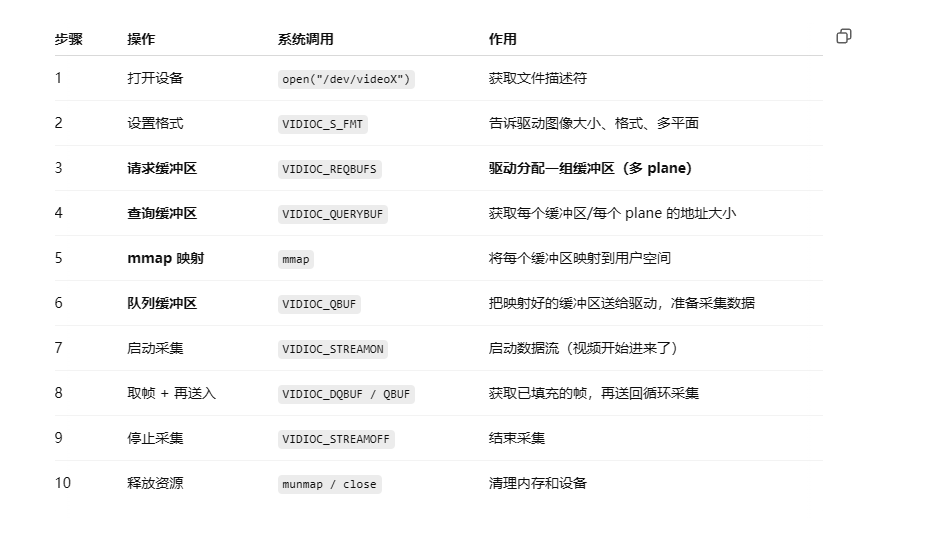鱼眼摄像头(一)多平面格式 单缓冲读取图像并显示
1.摄像头格式
1. 单平面格式(Single Plane):各通道数据保存在同一个平面(缓冲),图像数据按行连续存储a. mjpeg,yuyv等,适用于轻量级或者简单场景
2. 多平面格式(Multi-plane):图像数据分别保存在多个平面(缓冲)a. NV12,Y平面+UV平面b. 每个平面都有自己单独的物理内存缓冲区。因此对于ISP,写入DMA等场景来说分通道处理更高效c. 代码层面对于多平面数据的采集可以借助v4l2
2.流程图

3.重要流程详解
- 设置格式
没搞懂为什么nv12反而还是设置一个plane,不是多平面么
bool V4L2MPlaneCamera::initFormat()
{struct v4l2_format fmt = {};fmt.type = V4L2_BUF_TYPE_VIDEO_CAPTURE_MPLANE;fmt.fmt.pix_mp.width = width_;fmt.fmt.pix_mp.height = height_;fmt.fmt.pix_mp.pixelformat = V4L2_PIX_FMT_NV12;fmt.fmt.pix_mp.num_planes = 1;return ioctl(fd_, VIDIOC_S_FMT, &fmt) >= 0;
}
- 请求缓冲区,获取申请的缓冲区信息,用于后续取数据
i. 测试可申请一个,但是读写可能会冲突,程序得等待写完再读,读的时候无法写,效率不高
ii. 实际工作根据场景申请3-6个,流水线采集,更稳定,也可根据需要申请更多6-12
bool V4L2MPlaneCamera::initMMap()
{if (!initFormat())return false;struct v4l2_requestbuffers req = {};req.count = 1;req.type = V4L2_BUF_TYPE_VIDEO_CAPTURE_MPLANE;req.memory = V4L2_MEMORY_MMAP;if (ioctl(fd_, VIDIOC_REQBUFS, &req) < 0)return false;struct v4l2_buffer buf = {};struct v4l2_plane planes[VIDEO_MAX_PLANES] = {};buf.type = V4L2_BUF_TYPE_VIDEO_CAPTURE_MPLANE;buf.memory = V4L2_MEMORY_MMAP;buf.index = 0; buf.m.planes = planes;buf.length = 1; if (ioctl(fd_, VIDIOC_QUERYBUF, &buf) < 0)return false;buffer_.length = buf.m.planes[0].length; buffer_.start = mmap(NULL, buf.m.planes[0].length, PROT_READ | PROT_WRITE, MAP_SHARED, fd_, buf.m.planes[0].m.mem_offset);return buffer_.start != MAP_FAILED;
}
- 启动采集,注意每次采集前必须设置缓冲区队列
ioctl(fd_, VIDIOC_QBUF, &buf)
bool V4L2MPlaneCamera::queueBuffer()
{struct v4l2_buffer buf = {};struct v4l2_plane planes[VIDEO_MAX_PLANES] = {};buf.type = V4L2_BUF_TYPE_VIDEO_CAPTURE_MPLANE;buf.memory = V4L2_MEMORY_MMAP;buf.index = 0; buf.length = 1; buf.m.planes = planes; planes[0].length = buffer_.length; return ioctl(fd_, VIDIOC_QBUF, &buf) >= 0;
}bool V4L2MPlaneCamera::startCapture()
{if (!queueBuffer())return false;enum v4l2_buf_type type = V4L2_BUF_TYPE_VIDEO_CAPTURE_MPLANE;return ioctl(fd_, VIDIOC_STREAMON, &type) >= 0;
}
- 取帧数据,再送入队列
根据前面获取到的缓冲区数据及mmap信息,直接取出缓冲区数据,转换为opencv格式并显示,最后再将取出的缓冲区放回队列,若不放回,驱动不会再写入数据
bool V4L2MPlaneCamera::readFrame(cv::Mat &bgr)
{fd_set fds;FD_ZERO(&fds);FD_SET(fd_, &fds);struct timeval tv = {1, 0};int r = select(fd_ + 1, &fds, NULL, NULL, &tv);if (r <= 0)return false;struct v4l2_buffer buf = {};struct v4l2_plane planes[VIDEO_MAX_PLANES] = {};buf.type = V4L2_BUF_TYPE_VIDEO_CAPTURE_MPLANE;buf.memory = V4L2_MEMORY_MMAP;buf.index = 0; buf.length = 1; buf.m.planes = planes; if (ioctl(fd_, VIDIOC_DQBUF, &buf) < 0)return false;cv::Mat yuv(height_ + height_ / 2, width_, CV_8UC1, buffer_.start);cv::cvtColor(yuv, bgr, cv::COLOR_YUV2BGR_NV12);if (!queueBuffer())return false;return true;
}
3.完整代码
#ifndef V4L2MPLANECAMERA_H
#define V4L2MPLANECAMERA_H#pragma once#include <linux/videodev2.h>#include <opencv2/opencv.hpp>
#include <string>
#include <vector>struct FormatInfo {std::string fourcc;std::string description;std::vector<std::pair<int, int>> resolutions;
};class V4L2MPlaneCamera {public:V4L2MPlaneCamera(const std::string &devPath, int width, int height);~V4L2MPlaneCamera();std::vector<FormatInfo> listFormats();bool openDevice();bool initMMap();bool startCapture();bool stopCapture();void closeDevice();bool readFrame(cv::Mat &bgr);private:struct Buffer {void *start;size_t length;};std::string devicePath_;int width_, height_;int fd_ = -1;Buffer buffer_;int bufferCount_ = 4;enum v4l2_buf_type bufferType_ = V4L2_BUF_TYPE_VIDEO_CAPTURE_MPLANE;bool initFormat();bool queueBuffer();
};#endif
#include "V4L2MPlaneCamera.h"#include <fcntl.h>
#include <sys/ioctl.h>
#include <sys/mman.h>
#include <unistd.h>#include <cstring>
#include <iostream>static std::string fourccToString(__u32 fmt);V4L2MPlaneCamera::V4L2MPlaneCamera(const std::string &devPath, int width,int height): devicePath_(devPath), width_(width), height_(height) {}V4L2MPlaneCamera::~V4L2MPlaneCamera() {stopCapture();closeDevice();
}bool V4L2MPlaneCamera::openDevice() {fd_ = ::open(devicePath_.c_str(), O_RDWR | O_NONBLOCK);return fd_ >= 0;
}bool V4L2MPlaneCamera::initFormat() {struct v4l2_format fmt = {};fmt.type = bufferType_;fmt.fmt.pix_mp.width = width_;fmt.fmt.pix_mp.height = height_;fmt.fmt.pix_mp.pixelformat = V4L2_PIX_FMT_NV12;fmt.fmt.pix_mp.num_planes = 1; return ioctl(fd_, VIDIOC_S_FMT, &fmt) >= 0;
}bool V4L2MPlaneCamera::initMMap() {if (!initFormat()) return false;struct v4l2_requestbuffers req = {};req.count = 1;req.type = bufferType_;req.memory = V4L2_MEMORY_MMAP;if (ioctl(fd_, VIDIOC_REQBUFS, &req) < 0) return false;struct v4l2_buffer buf = {};struct v4l2_plane planes[VIDEO_MAX_PLANES] = {};buf.type = bufferType_;buf.memory = V4L2_MEMORY_MMAP;buf.index = 0; buf.m.planes = planes;buf.length = 1; if (ioctl(fd_, VIDIOC_QUERYBUF, &buf) < 0) return false;buffer_.length = buf.m.planes[0].length; buffer_.start = mmap(NULL, buf.m.planes[0].length, PROT_READ | PROT_WRITE,MAP_SHARED, fd_, buf.m.planes[0].m.mem_offset);return buffer_.start != MAP_FAILED;
}bool V4L2MPlaneCamera::queueBuffer() {struct v4l2_buffer buf = {};struct v4l2_plane planes[VIDEO_MAX_PLANES] = {};buf.type = bufferType_;buf.memory = V4L2_MEMORY_MMAP;buf.index = 0; buf.length = 1; buf.m.planes = planes; planes[0].length = buffer_.length; return ioctl(fd_, VIDIOC_QBUF, &buf) >= 0;
}bool V4L2MPlaneCamera::startCapture() {if (!queueBuffer()) return false;return ioctl(fd_, VIDIOC_STREAMON, &bufferType_) >= 0;
}bool V4L2MPlaneCamera::readFrame(cv::Mat &bgr) {fd_set fds;FD_ZERO(&fds);FD_SET(fd_, &fds);struct timeval tv = {1, 0};int r = select(fd_ + 1, &fds, NULL, NULL, &tv);if (r <= 0) return false;struct v4l2_buffer buf = {};struct v4l2_plane planes[VIDEO_MAX_PLANES] = {};buf.type = bufferType_;buf.memory = V4L2_MEMORY_MMAP;buf.index = 0; buf.length = 1; buf.m.planes = planes; if (ioctl(fd_, VIDIOC_DQBUF, &buf) < 0) return false;cv::Mat yuv(height_ + height_ / 2, width_, CV_8UC1, buffer_.start);cv::cvtColor(yuv, bgr, cv::COLOR_YUV2BGR_NV12);if (!queueBuffer()) return false;return true;
}bool V4L2MPlaneCamera::stopCapture() {return ioctl(fd_, VIDIOC_STREAMOFF, &bufferType_) >= 0;
}void V4L2MPlaneCamera::closeDevice() {if (fd_ >= 0) {munmap(buffer_.start, buffer_.length);close(fd_);fd_ = -1;}
}std::vector<FormatInfo> V4L2MPlaneCamera::listFormats() {std::vector<FormatInfo> formats;if (fd_ < 0) {std::cerr << "[错误] 摄像头设备未打开。" << std::endl;return formats;}struct v4l2_fmtdesc fmtDesc = {};fmtDesc.type = bufferType_;std::cout << "[信息] 开始枚举支持的图像格式..." << std::endl;for (fmtDesc.index = 0; ioctl(fd_, VIDIOC_ENUM_FMT, &fmtDesc) == 0;fmtDesc.index++) {FormatInfo info;info.fourcc = fourccToString(fmtDesc.pixelformat);info.description = reinterpret_cast<char *>(fmtDesc.description);std::cout << " - 格式: " << info.fourcc << " (" << info.description << ")"<< std::endl;struct v4l2_frmsizeenum sizeEnum = {};sizeEnum.pixel_format = fmtDesc.pixelformat;bool hasResolution = false;for (sizeEnum.index = 0; ioctl(fd_, VIDIOC_ENUM_FRAMESIZES, &sizeEnum) == 0;sizeEnum.index++) {switch (sizeEnum.type) {case V4L2_FRMSIZE_TYPE_DISCRETE:std::cout << " 离散分辨率: " << sizeEnum.discrete.width << "x"<< sizeEnum.discrete.height << std::endl;info.resolutions.emplace_back(sizeEnum.discrete.width,sizeEnum.discrete.height);hasResolution = true;break;case V4L2_FRMSIZE_TYPE_CONTINUOUS:std::cout << " 连续分辨率范围: " << sizeEnum.stepwise.min_width<< "x" << sizeEnum.stepwise.min_height << " 到 "<< sizeEnum.stepwise.max_width << "x"<< sizeEnum.stepwise.max_height << "(任意值均可)"<< std::endl;hasResolution = true;break;case V4L2_FRMSIZE_TYPE_STEPWISE:std::cout << " 步进型分辨率: "<< "宽度 [" << sizeEnum.stepwise.min_width << "~"<< sizeEnum.stepwise.max_width << "] 步长 "<< sizeEnum.stepwise.step_width << ",高度 ["<< sizeEnum.stepwise.min_height << "~"<< sizeEnum.stepwise.max_height << "] 步长 "<< sizeEnum.stepwise.step_height << std::endl;hasResolution = true;break;default:std::cerr << " [警告] 未知分辨率类型: " << sizeEnum.type<< std::endl;break;}}if (!hasResolution) {std::cerr << " [警告] 无可用分辨率" << std::endl;}formats.push_back(info);}if (fmtDesc.index == 0) {std::cerr << "[警告] 未能枚举到任何图像格式!" << std::endl;} else {std::cout << "[信息] 完成格式枚举,总共: " << fmtDesc.index << " 种格式"<< std::endl;}return formats;
}
static std::string fourccToString(__u32 fmt) {char str[5];str[0] = fmt & 0xFF;str[1] = (fmt >> 8) & 0xFF;str[2] = (fmt >> 16) & 0xFF;str[3] = (fmt >> 24) & 0xFF;str[4] = '\0';return std::string(str);
}

